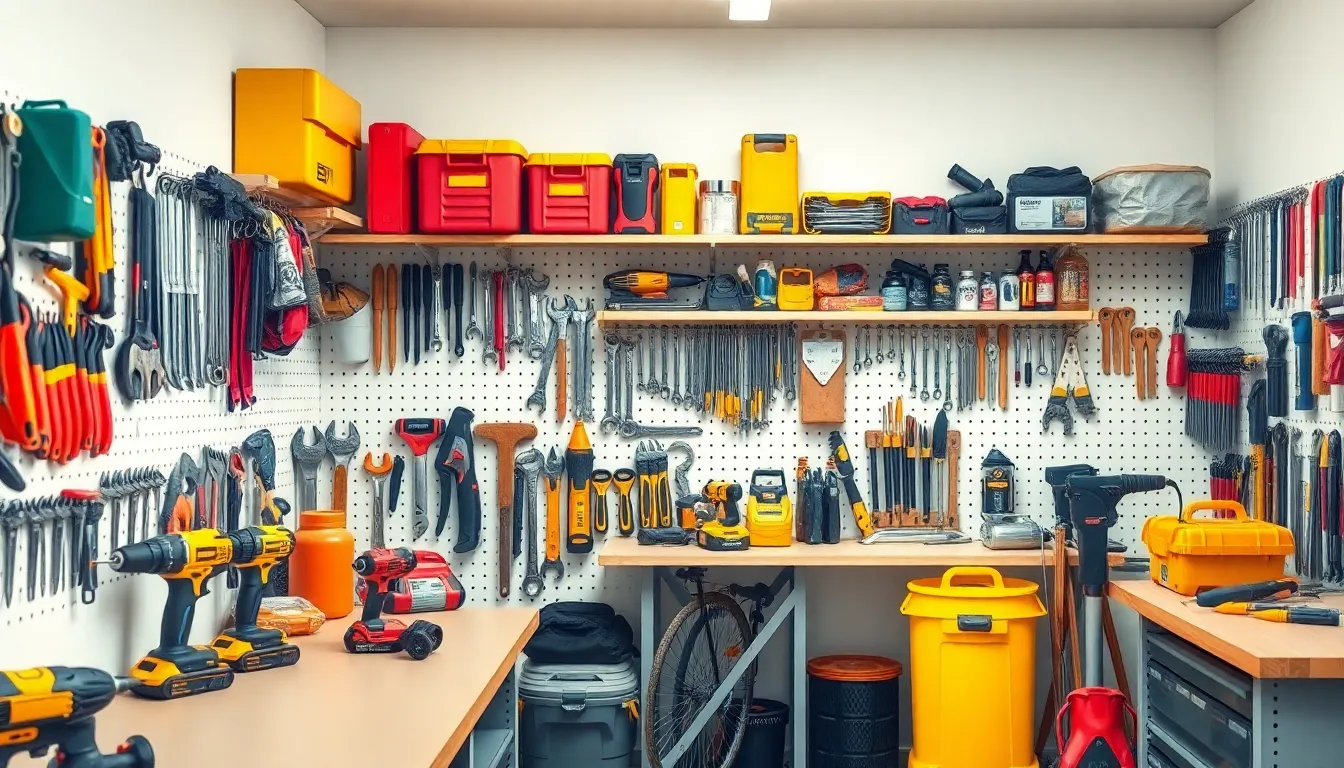Table of Contents
ToggleEvery workshop has that moment when chaos reigns supreme. Tools are scattered like confetti at a party, and finding that one wrench feels like a scavenger hunt gone wrong. But fear not! Organizing tools doesn’t have to be a dull chore. With a little creativity and some clever strategies, it can be as satisfying as cracking open a cold drink after a long day.
Importance Of Organizing Tools In Workshop
Organizing tools enhances efficiency in any workshop. A structured workspace reduces time spent searching for equipment, allowing projects to progress smoothly. Clear organization minimizes frustration, leading to a more enjoyable working environment.
Safety improves significantly with organized tools. Misplaced equipment can cause accidents and injuries. Keeping similar tools together fosters a safer environment by reducing tripping hazards.
Professionalism is another benefit of well-organized tools. A tidy space reflects commitment and diligence. Clients and visitors perceive a well-maintained workshop as a mark of reliability and expertise.
Increased productivity often results from streamlined organization. By having tools readily accessible, tasks can be completed quicker. A study indicates that organized workspaces can boost work output by up to 25 percent.
Creative opportunities arise in a well-organized workshop. When tools are easy to find, experimentation with new techniques and projects becomes more feasible. This fosters innovation and encourages skill development.
Cost savings materialize through effective tool organization. When tools are misplaced, the likelihood of replacing them increases. Maintaining an organized space ensures that equipment remains intact and available for use, saving money over time.
Assessing Your Current Tool Collection

Assessing the current tool collection starts with a clear understanding of what’s available. This initial step lays the groundwork for effective organization.
Inventorying Tools
Begin by listing all tools. Create a detailed inventory that includes the type, size, and condition of each item. Categorize tools by function, such as cutting, measuring, and fastening. Utilize a digital spreadsheet or a simple notebook for easier updates in the future. This systematic approach provides insight into what’s essential and what’s redundant in the workshop.
Identifying Frequently Used Tools
Identify tools used most often in daily tasks. Track usage over a few weeks to determine which items contribute most to productivity. Frequent items typically include drills, saws, and wrenches, making them prime candidates for accessible storage. Prioritizing space for these tools reduces time searching and increases efficiency. Consider placing them in a dedicated area or toolbox for quick retrieval. Ensuring easy access to these essentials streamlines workflow and enhances overall project execution.
Choosing The Right Storage Solutions
Selecting appropriate storage options is crucial for maintaining an organized workshop. Various tools require different solutions based on size, frequency of use, and accessibility.
Toolboxes And Tool Chests
Toolboxes and tool chests provide portable and secure storage for hand tools. They come in various sizes, accommodating different needs. Opt for a toolbox with compartments to separate smaller tools like screwdrivers and pliers. A larger tool chest often features drawers, allowing for organized storage of heavier tools such as wrenches and hammers. Many options also include lockable features for security, protecting valuable equipment from theft or damage.
Wall-Mounted Racks And Pegboards
Wall-mounted racks and pegboards maximize vertical space efficiently. By using these solutions, users can keep frequently used tools readily available and in sight. Customizable pegboards allow for flexible arrangements, adapting to changing needs or tool additions. Wall-mounted racks can support heavier items such as saws or levels, freeing up valuable floor space. Positioning tools at eye level enhances accessibility, contributing to a more efficient workflow.
Drawer Organizers And Bins
Drawer organizers and bins offer structured storage for small items and accessories. These options help categorize screws, nuts, bolts, and other miscellaneous items for easy access. Choosing clear bins allows users to view contents without opening them, saving time during projects. Drawer organizers can also be customized to fit various drawer sizes, making them versatile. Labels on bins enhance organization, ensuring that each item finds its designated space and reducing clutter.
Organizing Tools By Category
Organizing tools by category simplifies retrieval and streamlines workflow. This methodical approach enhances efficiency, especially in busy workshops.
Hand Tools
Hand tools include wrenches, hammers, and screwdrivers. Storing these tools in portable toolboxes allows easy transport. Wall-mounted racks keep frequently used items like pliers and scissors visible. Labeling each section improves identification, reducing time spent searching. Using drawer organizers for small hand tools prevents clutter and maintains order.
Power Tools
Power tools such as drills, saws, and sanders require specific storage solutions. Shelving units work well for larger items, ensuring safe storage and quick access. Placing battery chargers near power tools maintains readiness for use. Clearly marking the location of each item helps in swift identification. Keeping cords organized with cable ties prevents tangling, enhancing safety.
Accessories And Supplies
Accessories and supplies, including screws, nails, and glue, require dedicated storage. Utilizing clear bins allows easy visibility of contents, making selection straightforward. Grouping items by type, such as fastening components in one container, simplifies retrieval. Labeling bins ensures that finding specific items is hassle-free and efficient. Regularly assessing inventory reveals when to restock essential supplies.
Implementing A Maintenance Routine
Establishing a maintenance routine is vital for keeping tools in optimal condition. Regular upkeep enhances longevity and maintains functionality.
Regular Tool Cleaning
Regular cleaning of tools prevents rust and ensures reliable performance. Use a soft cloth or brush to remove dirt and debris after each use. Squeezing out excess moisture from wet tools prevents corrosion. Maintaining clean surfaces promotes a safe working environment, as dirt-free tools reduce the risk of slips and mishaps. Implementing a monthly deep cleaning regimen for frequently used items helps catch buildup before it becomes problematic. Additionally, investing in proper cleaning solutions tailored to specific materials can enhance the effectiveness of the cleaning process.
Checking For Damage
Checking tools for damage should occur during every maintenance routine. Inspecting blades, handles, and cords ensures that tools function safely and effectively. Noticeable wear indicates the need for repair or replacement, while minor issues can often be addressed through simple fixes. Tools showing signs of damage pose risks during operation, which compromises both safety and productivity. Establish a schedule for thorough checks that coincide with cleaning sessions to streamline the maintenance process. Documenting any issues helps track repair history and informs future maintenance needs.
Organizing tools in a workshop transforms chaos into efficiency. By implementing creative strategies and effective storage solutions, individuals can create a workspace that enhances productivity and safety. A well-structured environment not only reduces time spent searching for tools but also fosters a sense of professionalism that impresses clients and visitors.
Regular maintenance and assessment ensure tools remain in top condition, supporting a smooth workflow. Embracing these organization techniques can lead to significant improvements in project execution and even cost savings over time. With the right approach, anyone can turn their workshop into a well-oiled machine that inspires creativity and innovation.





